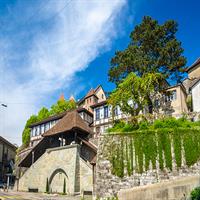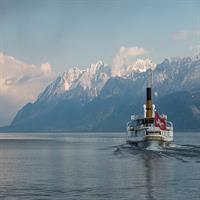Day 1 in Lausanne
Welcome to Lausanne! Upon arrival, you will go through customs and
immigration. Should you opt to purchase
a transfer to your hotel; a representative will be waiting for you as you exit
immigration. Arrive at your hotel, check
in and do not give in to jet lag! There
is so much for you to see and do.
Once you arrive in town, make your way
to the city center to wander around and take in the charming atmosphere and architectural style. The city center spreads
down a hill from the Medieval
Cite at the top through the pedestrian Old Town to the trendy warehouse district of Flon
and then down to the main train station. The streets can be quite steep,
but everything is linked by bridges, escalators, steps and lifts, not to
mention the handy Metro.
As
you stroll, you may find yourself getting lost, but this is half the fun. Make
sure you explore the pretty Escaliers
du Marche, one of the most
picturesque sights in Lausanne. It is the long covered flight of steps leading
from above Place de la Palud to the terrace in front of the
main door to the cathedral. Dating back to 1717, the stairs are lined on one
side by a row of houses and restaurants which date back to the 16th century.
The
Place de Palud,
the Old Town`s main square and home to the town hall, is a great place to stop
for a coffee at one of the cafes. This area has a large draw for locals and
tourists alike. The wide cobblestoned square has colorful fountains and a large
cookoo-style clock complete with robotic marching soldiers. On Saturday and
Wednesdays the square and surrounding streets fill up with market stalls which
are well work a browse.
One
of the city`s icons is the Cathedral
of Notre Dame of Lausanne, which is set on a hillside and
overlooks the town below with its towers and stained glass marvels. The
Cathedral itself dates back to as early as 1170, with a consecration date of
1275 and a nearby lookout point that is popular with present day photographers.
Nearby,
among various shopping streets, you`re likely to come across Blondel, the city`s renowned chocolatier
(situated next to the go-to option for luxury macarons, Ladurée). While
Blondel`s hand-crafted sugary goodness is definitely worth a taste, it does
come at a price.
With its
considerable student population, the city is also filled with more modern
creative expressions, from colorful mural-style graffiti to typographic
wonders. The area around Lausanne`s school for music and jazz is filled with
interesting bars, restaurants, shops and a cinema.
Finish your day strolling along the
shores of Lake Geneva
and the Ouchy
area filled with parks, public art works and a harbor full of yachts and swans. Grab a crêpe or ice cream, wander around the
park or take a seat on a bench overlooking the lake and breathe it all in. Aside from its sights and nature however, Lausanne
is also a food and drink hub that attracts people from cities all around.




Day 2 in Lausanne
Wake up early
today to continue exploring Lausanne. Start by enjoying the beautiful Lake
Geneva that offers stunning views of the French Alps with the lake in the foreground.
The shore from Lausanne east as far as Montreux is known as the Swiss Riviera, a sun-drenched landscape of gardens, palm trees, and
picturesque villages. The best way to enjoy the lake is to board one of the lake steamers that stop here
and either take a cruise or use it to hop between towns. Ferries shuttle
between Lausanne and two French towns across the lake. The most popular of
these is the spa town of Évian-les-Bains, a
scenic 35-minute ride away. Equally scenic are the rides to Geneva and Montreux, or you can take a
dinner or lunch cruise. The most popular cruises are on the Belle Époque paddle
steamers Montreux (1904) and the elegant La
Suisse (1910).
You can buy day tickets for unlimited CGN boat travel or use a Swiss Railway
pass, which is valid on CGN boats.
We highly
recommend making some time in the day to visit the impressive Olympic
Museum, established in 1993 it is the largest of its kind in the
world. Divided into three themes, the permanent exhibition leans on
interactive, multimedia displays, including games to test your own physical and
psychological skills in Olympic disciplines. The Museum has the Olympic Torches of all the Games played so
far, and it also keeps the pieces of equipment that the athletes required to
win their gold medals. The café-restaurant also here offers fantastic
views of the lake.
Another
museum worth checking out in town is the Lausanne-Vidy
Roman Museum. In Roman times, Vidy, west of Ouchy along the lake
shore, was the port of Lousonna, an important trading colony at the
intersection of routes from the Mediterranean and the Rhine. The city of 1,500
to 2,000 traders, fishermen, and craftspeople thrived from the late first
century well into the fourth, and their story is told at the Roman Museum.
Here, you`ll see the remains of a wealthy residence, with painted rooms, an
atrium, and luxuries such as heated floors. Through exhibits based on the
artifacts unearthed here - bronze objects, coins, ceramics, glass, and
household implements - you can get an idea of daily life in a Roman outpost two
millennia ago. An archaeological walk takes you among the ruins of Lousonna`s
ancient forum.
Enjoy
the remaining part of your day exploring the Flon
Quarter an ultra-contemporary
new art zone, where designer-architects have created buildings that are not
just 21st-century but border futuristic. The former area of 19th-century warehouses is now a energetic quarter of
striking and colorful buildings filled with shops, restaurants, business
offices, designer galleries, and artists` studio space. Its central avenue
opens into plazas where locals gather in good weather in cafés and on benches
under a giant abstract tree. The entire area seems constantly alive: in the
winter an open space becomes a skating rink, and at night, the buildings are spectacularly
lighted. As if to underscore the quarter`s dynamic and forward approach as well
as Lausanne`s position as one of Europe`s greenest cities.



Day 3 in Lausanne
On your last day in Lausanne continue
to explore more of the attractions this beautiful city has to offer. We highly
recommend a visit to the Collection de l`Art Brut, one of the world`s leading museums for outsiders art founded by French
artist Jean Dubuffet`s contribution of his private collection of works by
untrained artists. Works by more than 1,000 artists outside the mainstream creative community
make up the collections, which include naïve paintings, sculpture, masks, and
works in a wide variety of media. The exhibitions change, following various
themes that interpret the art and explore the creative process. The collections
are housed in the splendid Château
de Beaulieu, in the center of the city.
An alternative art
museum, the Hermitage Foundation, offers a fantastic art collection of more than 650 works that represent
prominent artists, especially Impressionist and post-Impressionist painters. Artists represented include
Manet, Cézanne, Degas, Monet, Boudin, Van Gogh, Fantin-Latour, Vuillard, and
Braque. The museum also exhibits a major collection of works by 20th-century
artists of the Vaud region. The foundation is housed in an elegant lakeside
house surrounded by gardens.
Sticking with the
arts theme, Lausanne is also home to the Musee des Beaux
Arts (Fine Art Museum), a museum
that houses an art collection of impressive quality of French artists. The museum offers works by
Paul Cézanne, Edgar Degas, Auguste Renoir, Pierre Bonnard, Albert Marquet,
Henri Matisse, and Maurice Utrillo, along with a good collection of graphic
works by Swiss artists. In the same palace are several other canton museums.
The Archaeological and Historical Museum exhibits
archaeological finds from the area, including Neolithic, Bronze and Iron Age,
and Roman artifacts. The Natural History and Zoological
Museum shows
animals from throughout the world, some of them extinct species.
Take the
rest of the afternoon to enjoy the great outdoors, head to the Sauvabelin
Tower. The tower was built
to mark the turn of the millennium, standing in the middle of a forest on a
hill above Lausanne. The unusual round structure is filled by a wide spiral
staircase of 302 steps, leading to an observation deck high above the treetops.
From this vantage point, the 360-degree view encompasses the city of Lausanne,
Lake Geneva, the Swiss Alps, and into the Jura region. The tower is built in a
park with a small lake, where you can take boat rides, and there is a
playground and small animal park for children. The park and tower are free, and
from March through October the tower is open until 9pm. It is a beautiful
location to watch the sunset.
Alternatively, wind down your day
at Park de Mon Repos a perfect spot for a leisurely stroll
on one of the most famous green spots of the city. It is home to Swiss aristocracy
for many years and later the International Olympic Committee. The park offers a
peaceful sanctuary of lush grass, richly colored petals, sprinkling fountains
and aviaries where countless exotic birds call home.
As evening approaches, enjoy exploring
the city at night. Lausanne is full of a variety of culture and excellent cuisine.
Enjoy some local favorites such as the famous fondue of Lausanne. For something
on the fancier side, the Lausanne
Palace or Ouchy`s
Beau-Rivage Palace, are both top culinary destinations. The
Lausanne Palace`s Michelin-starred Table d`Edgard offers amazing views of the
Alps and lake. For many bars, nightlife and
more artsy destinations, head to the modern Flon district.




Additional Days in Lausanne
Should you be able to
spend additional days in Lausanne we recommend a day trip to the Château
de Chillon rising directly out
of the lake outside Montreux. The Chateau dates to the 9th-century
and is the setting for Byron`s The Prisoner of Chillon, based on a true story.
The oldest parts, which you`ll see on the route through the castle`s 20-plus
buildings, are the keep and the Duke`s Tower, which are linked by an internal
wall, the living quarters, and the square tower above the entrance. In the
underground vaults, enormous pillars and Gothic vaulting are carved out of bedrock,
and here you`ll see the iron ring that restrained Francois de Bonivard, the
famed prisoner of the Duke of Savoy.
The entire complex is interesting and well interpreted by signage
and costumed guides, but particularly remarkable are the large kitchen, the
banqueting hall, the adjoining Bernese Room adorned with floral motifs, and the
superb Heraldic Hall. In the old tower are the Duke`s apartments, where you can
see traces of the rich 13th- and 14th-century decoration with birds and
flowers. The vaulted St. George`s Chapel is completely decked out with figures
and tendrils. The Count`s Great Hall has a 15th-century coffered ceiling and
four windows with quatrefoils above two 13th-century Gothic arches.

Your Last Day in Lausanne
Depart your hotel for the airport for your return home. We recommend that you purchase a private transfer, if so a representative will meet you at the hotel in time to take you to the airport for your flight out.
